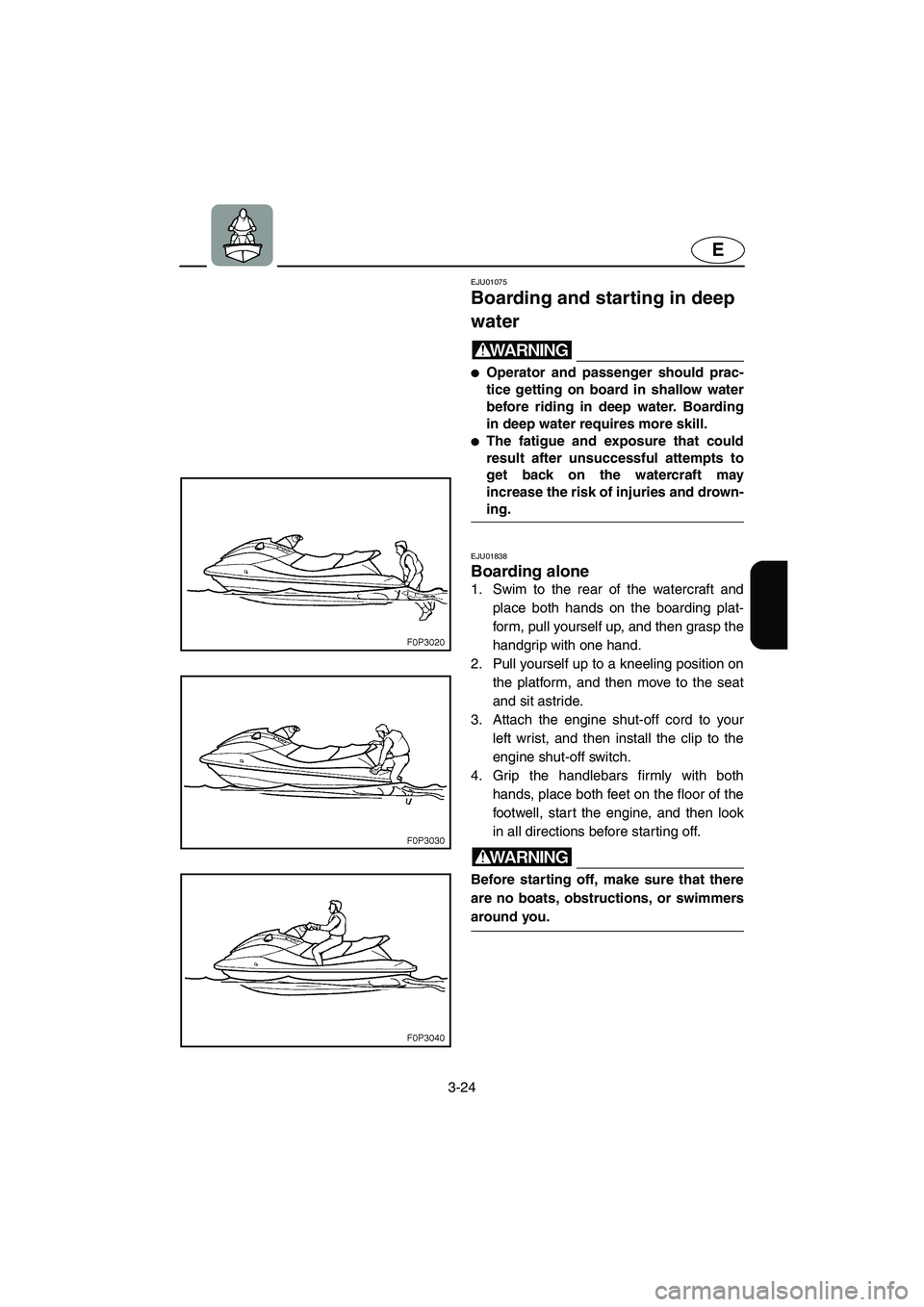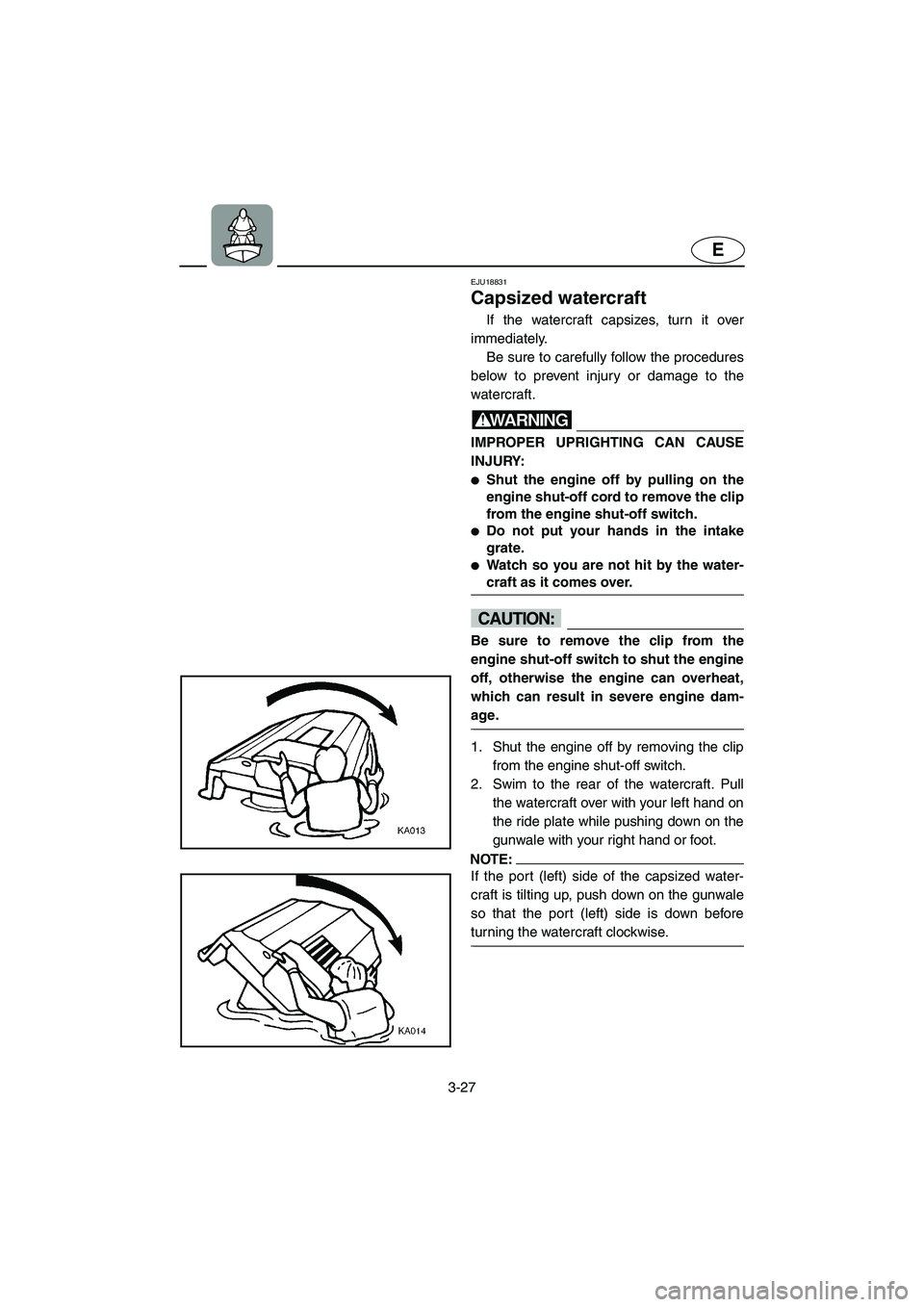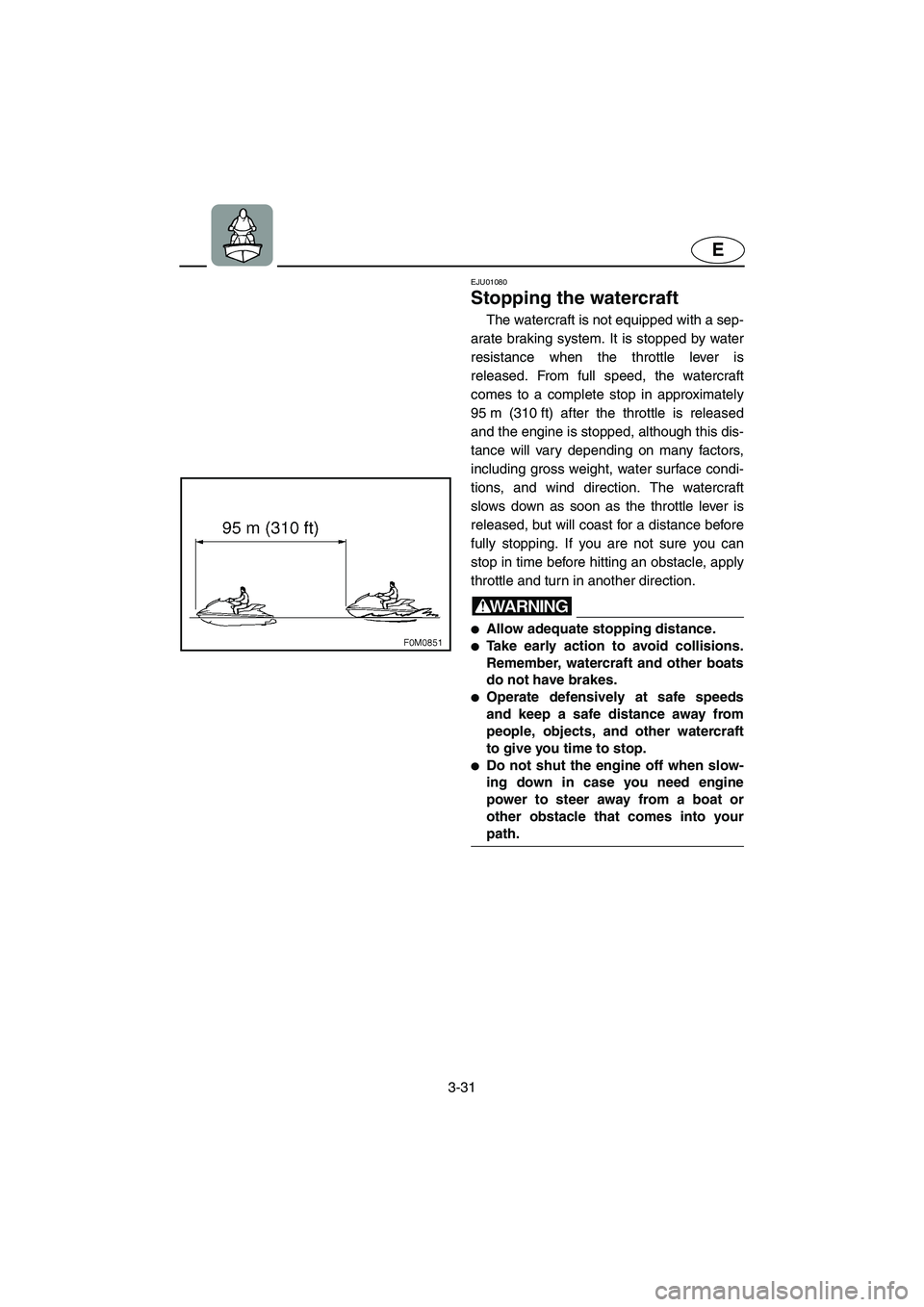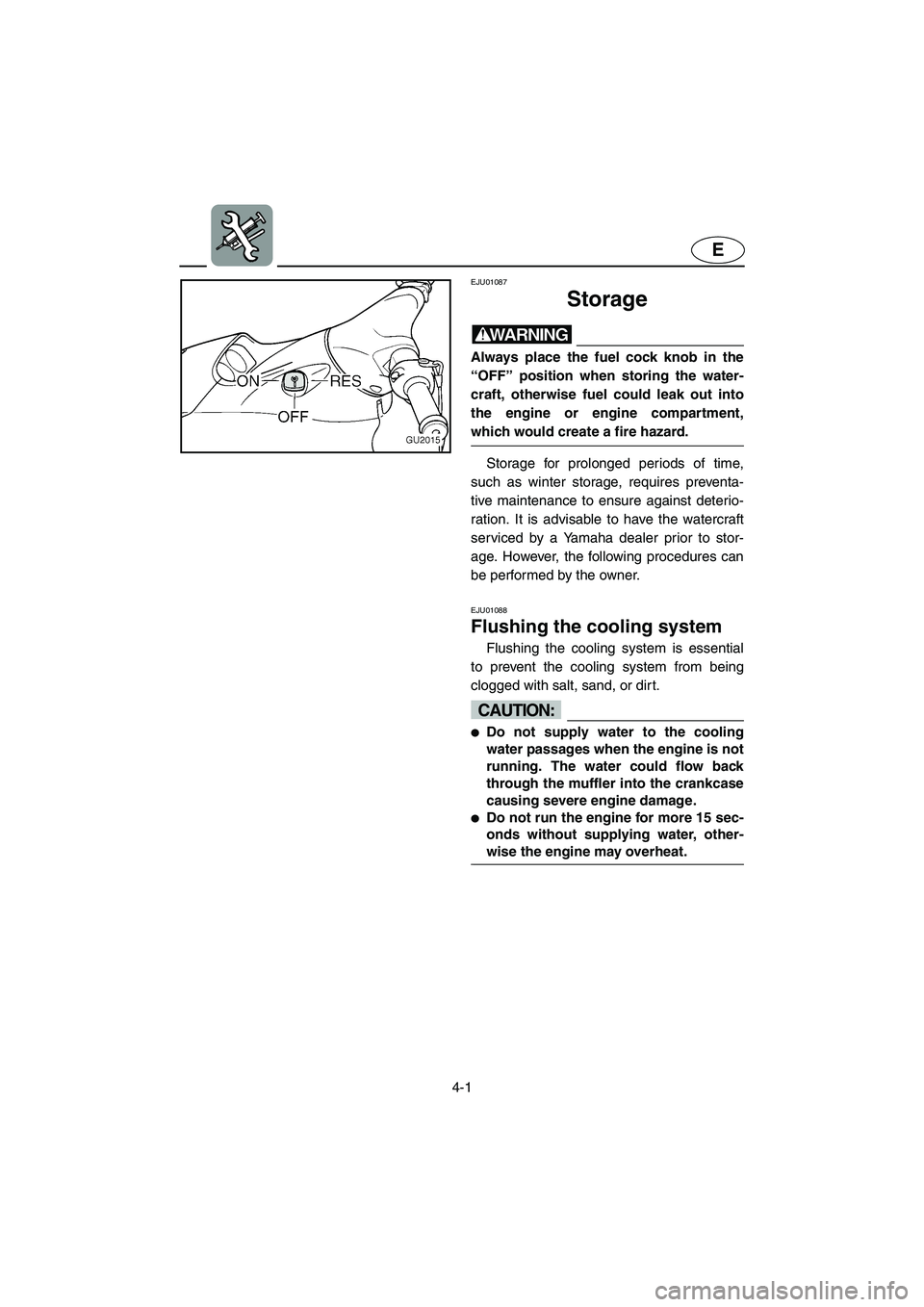Page 65 of 120
3-22
E
EJU01837
Starting the watercraft
WARNING@ �Scan constantly for people, objects,
and other watercraft. Be alert for con-
ditions that limit your visibility or block
your vision of others.
�Operate defensively at safe speeds
and keep a safe distance away from
people, objects, and other watercraft.
�Do not follow directly behind water-
craft or other boats. Do not go near
others to spray or splash them with
water. Avoid sharp turns or other
maneuvers that make it hard for others
to avoid you or understand where you
are going. Avoid areas with sub-
merged objects or shallow water.
�Take early action to avoid collisions.
Remember watercraft and other boats
do not have brakes. Do not release the
throttle when trying to steer away from
objects—you need throttle to steer.
�Practice reboarding in shallow water
before riding in deep water.
@
UF0M75.book Page 22 Thursday, May 29, 2003 9:53 AM
Page 67 of 120

3-24
E
EJU01075
Boarding and starting in deep
water
WARNING@ �Operator and passenger should prac-
tice getting on board in shallow water
before riding in deep water. Boarding
in deep water requires more skill.
�The fatigue and exposure that could
result after unsuccessful attempts to
get back on the watercraft may
increase the risk of injuries and drown-
ing.
@
EJU01838
Boarding alone
1. Swim to the rear of the watercraft and
place both hands on the boarding plat-
form, pull yourself up, and then grasp the
handgrip with one hand.
2. Pull yourself up to a kneeling position on
the platform, and then move to the seat
and sit astride.
3. Attach the engine shut-off cord to your
left wrist, and then install the clip to the
engine shut-off switch.
4. Grip the handlebars firmly with both
hands, place both feet on the floor of the
footwell, start the engine, and then look
in all directions before starting off.
WARNING@ Before starting off, make sure that there
are no boats, obstructions, or swimmers
around you.
@
UF0M75.book Page 24 Thursday, May 29, 2003 9:53 AM
Page 68 of 120

3-25
E
EJU01849
Boarding with passengers
WARNING@ Severe internal injuries can occur if
water is forced into body cavities as a
result of being near the jet thrust nozzle.
Do not apply throttle until each passen-
ger is seated with his or her feet on the
floor of the footwell and is holding on to
the person in front of him or her.
@
1. Climb on board as noted in the previous
section, and sit astride the seat. Attach
the engine shut-off cord to your left wrist,
and then install the clip to the engine
shut-off switch.
2. Have the passenger move to the rear of
the watercraft.
3. Have the passenger get on board and sit
on the seat. If a second passenger is
getting on, have him or her follow the
same procedure.
NOTE:@ When a passenger is getting on board, both
he and the operator should try to balance
the watercraft.
@
4. The operator should check to see that
the passengers have their feet on the
floor of the footwell and that they are
securely holding on to the person in front
of them.
5. Start the engine, look in all directions,
and then accelerate to planing speed.
WARNING@ Before starting off, make sure that there
are no boats, obstructions, or swimmers
around you.
@
UF0M75.book Page 25 Thursday, May 29, 2003 9:53 AM
Page 70 of 120

3-27
E
EJU18831
Capsized watercraft
If the watercraft capsizes, turn it over
immediately.
Be sure to carefully follow the procedures
below to prevent injury or damage to the
watercraft.
WARNING@ IMPROPER UPRIGHTING CAN CAUSE
INJURY:
�Shut the engine off by pulling on the
engine shut-off cord to remove the clip
from the engine shut-off switch.
�Do not put your hands in the intake
grate.
�Watch so you are not hit by the water-
craft as it comes over.
@
CAUTION:@ Be sure to remove the clip from the
engine shut-off switch to shut the engine
off, otherwise the engine can overheat,
which can result in severe engine dam-
age.
@
1. Shut the engine off by removing the clip
from the engine shut-off switch.
2. Swim to the rear of the watercraft. Pull
the watercraft over with your left hand on
the ride plate while pushing down on the
gunwale with your right hand or foot.
NOTE:@ If the port (left) side of the capsized water-
craft is tilting up, push down on the gunwale
so that the port (left) side is down before
turning the watercraft clockwise.
@
UF0M75.book Page 27 Thursday, May 29, 2003 9:53 AM
Page 73 of 120
3-30
E
WARNING@ �Do not release the throttle when trying
to steer away from objects—you need
throttle to steer. A collision could
result in severe injury or death.
�When operating at higher speeds,
make gradual turns or slow down
before turning. Sharp high-speed turns
may cause the watercraft to slide side-
ways or spin, throwing the operator
and passengers overboard which
could cause an injury.
@
UF0M75.book Page 30 Thursday, May 29, 2003 9:53 AM
Page 74 of 120

3-31
E
EJU01080
Stopping the watercraft
The watercraft is not equipped with a sep-
arate braking system. It is stopped by water
resistance when the throttle lever is
released. From full speed, the watercraft
comes to a complete stop in approximately
95 m (310 ft) after the throttle is released
and the engine is stopped, although this dis-
tance will vary depending on many factors,
including gross weight, water surface condi-
tions, and wind direction. The watercraft
slows down as soon as the throttle lever is
released, but will coast for a distance before
fully stopping. If you are not sure you can
stop in time before hitting an obstacle, apply
throttle and turn in another direction.
WARNING@ �Allow adequate stopping distance.
�Take early action to avoid collisions.
Remember, watercraft and other boats
do not have brakes.
�Operate defensively at safe speeds
and keep a safe distance away from
people, objects, and other watercraft
to give you time to stop.
�Do not shut the engine off when slow-
ing down in case you need engine
power to steer away from a boat or
other obstacle that comes into your
path.
@
UF0M75.book Page 31 Thursday, May 29, 2003 9:53 AM
Page 79 of 120
3-36
E
EJU01085
Transporting
WARNING@ Always place the fuel cock knob in the
“OFF” position when transporting the
watercraft, otherwise fuel could leak out
into the engine or engine compartment,
which would create a fire hazard.
@
When transporting the watercraft on a
trailer, secure the tie downs to the trailer
through the bow eye and stern rope holes.
CAUTION:@ Do not route ropes or tie downs over the
seat, as they may leave permanent marks
on the seat’s surface. Also, wrap the
ropes or tie downs with towels or rags
where they touch the body of the water-
craft to avoid scratching or damage.
@
UF0M75.book Page 36 Thursday, May 29, 2003 9:53 AM
Page 82 of 120

4-1
E
EJU01087
Storage
WARNING@ Always place the fuel cock knob in the
“OFF” position when storing the water-
craft, otherwise fuel could leak out into
the engine or engine compartment,
which would create a fire hazard.
@
Storage for prolonged periods of time,
such as winter storage, requires preventa-
tive maintenance to ensure against deterio-
ration. It is advisable to have the watercraft
serviced by a Yamaha dealer prior to stor-
age. However, the following procedures can
be performed by the owner.
EJU01088
Flushing the cooling system
Flushing the cooling system is essential
to prevent the cooling system from being
clogged with salt, sand, or dirt.
CAUTION:@ �Do not supply water to the cooling
water passages when the engine is not
running. The water could flow back
through the muffler into the crankcase
causing severe engine damage.
�Do not run the engine for more 15 sec-
onds without supplying water, other-
wise the engine may overheat.
@
UF0M75.book Page 1 Thursday, May 29, 2003 9:53 AM